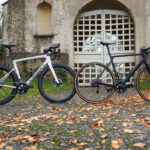Many cyclists seek realism in their indoor cycling experience, particularly when using platforms like Zwift with a spinning bike. This realism generally falls into two categories: the sensation of speed and distance on flat roads compared to outdoor cycling, and the change in pedaling difficulty when encountering hills. While replicating the feel of hills on a standard spin bike presents significant challenges, achieving realistic flat road riding is definitely within reach.
To optimize your spin bike setup for flat Zwift routes, the key is understanding your real-world cycling performance. Begin by determining your average distance on a genuinely flat road in a set time, say 30 minutes, and note how this effort feels physically. This real-world benchmark becomes your target for Zwift realism.
Once you’re on Zwift with your spin bike, you’ll need to make adjustments to your setup. This might involve tweaking the spin bike’s resistance setting (though ideally, you’ll set this once and leave it), and ensuring Zwift accurately reflects your spin bike’s wheel diameter if prompted. The goal is to manipulate these variables until your 30-minute Zwift ride on a flat course, such as Zwift’s Fuego Flats, reports a distance that closely matches your real-world flat road test, and the perceived effort feels comparable. It’s crucial to prioritize the distance reported within Zwift over any metrics from your spin bike’s console or a separate app like Wahoo, as Zwift is the environment you’re trying to make realistic.
After configuring your setup for flat road realism, it’s important to understand how Zwift handles hills with a non-smart spin bike, often referred to as a “dumb” trainer setup. With a dumb trainer selected in Zwift, you should avoid adjusting the spin bike’s resistance during your ride. Zwift will simulate hills by adjusting your in-game speed based on the gradient of the virtual terrain. You won’t feel an increase in resistance like you would on a smart trainer or outdoors, but you will notice your avatar slowing down as the incline increases, mirroring how other riders around you in Zwift will react to the hill.
Resist the temptation to manually increase the spin bike’s resistance to simulate hills. Doing so will likely confuse Zwift’s algorithm, leading to an unrealistically slow speed as Zwift and your manual resistance adjustment compound the perceived difficulty. For the most consistent and enjoyable experience with a spin bike on Zwift, especially when starting out, focus on riding flatter Zwift routes. This approach allows you to become accustomed to the Zwift environment and get a feel for virtual cycling.
If you find yourself enjoying Zwift and desire a more immersive and realistic experience, particularly with hill simulation, consider investing in Zwift-controllable options like smart trainers or smart bikes. These devices automatically adjust resistance to match the virtual terrain, providing a significantly more realistic and engaging indoor cycling experience. However, for achieving a credible flat road cycling feel on Zwift with a spin bike, focusing on proper setup and sticking to flatter routes is an excellent starting point.

